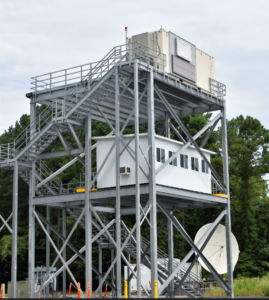The Navy this month issued a second Request For Information (RFI) seeking market research on interest on the future development and production phases for the Future B-band Radar (FXR).
This follow a previous January 2022 RFI notice that said the FXR project seeks to provide horizon search and track, surface search and track, periscope detection and discrimination and missile communications in a wide variety of maritime environments and conditions across several classes of ships. The government prefers this including a common system architecture across the various platforms to the largest extent possible.

The Navy hopes to have FXR ultimately replace the AN/SPQ-9B X-Band radar. According to a Navy factsheet, SPQ-9B scans out to the horizon and “performs simultaneous and automatic air and surface target detection and tracking of low flying Anti-Ship Cruise Missiles (ASCMs), surface threats and low/slow flying aircraft, UAVs and helicopters.”
FXR is a project of the Program Executive Office Integrated Warfare Systems Above Water Sensors and Lasers directorate (PEO IWS 2.0).
At the time, the Navy notice said it wants FXR to meet mission performance and size, weight and power-cooling (SWAP-C) for the Arleigh Burke-class Flights II, IIA and III destroyers equipped with the Aegis Baseline 9 and 10 combat systems; Ford-class and Nimitz-class aircraft carriers with Ship Self-Defense System Baseline 12 combat system; San Antonio-class Landing Platform/Dock (LPD-29+) hulls with SSDS Block 12 too; and Ticonderoga-class cruisers with Aegis Baseline 9.
The newest Jan. 16 RFI specifically covers market research seeking industry inputs and interest for future development and production phases for FXR.
The government said it is interested in ultimately procuring FXR from companies that have past experience developing, integrating, testing and manufacturing complete radar systems, radio frequency electronics, digital communications networks and similar systems; teaming with industry partners on subsystem development; cooperating with other prime partners to integrate complex systems; and maintaining fielded Defense Department or military hardware systems.
The notice said the RFI is divided into acquisition and technical sections, with the former due by Feb. 6 in unclassified form and the latter due Feb. 13 with an option to be classified at the secret level.
The RFI also noted the government plans to use selected support contractors from several academic and corporate institutions to provide subject matter technical expertise to review RFIs and various interactions. These include personnel from Johns Hopkins University Applied Physics Laboratory, DPM Consulting, Serco Inc., Innovative Concepts Engineering, Technology Management Solutions, Technology Service Corporation, Systems Planning and Analysis, Amentum and Solution Development Corporation.
The earlier 2022 edition of the FXR RFI said those responses should address several questions including the respondent’s FXR system concept or applicable technologies, predicted performance and system design; if an existing system is mature enough to start production; identify the technology readiness level of enabling technologies in the concept for Navy requirements; past experience developing Navy radars, manufacturing facilities the company has; what capital investments are planned for the system design and test; and experience and experience with model-based systems engineering.